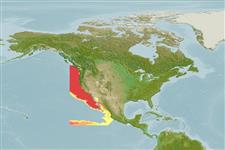>
Gadiformes (Cods) >
Merlucciidae (Merluccid hakes)
Etymology: Merluccius: Latin, mar, maris = the sea + Latin, lucius = pike (Ref. 45335).
More on author: Ayres.
Environment: milieu / climate zone / depth range / distribution range
Sinh thái học
Biển; Thuộc về nước lợ; Mức độ sâu 0 - 1000 m (Ref. 9316), usually ? - 229 m (Ref. 2850). Temperate; 51°N - 15°N, 130°W - 77°W (Ref. 58452)
Eastern Pacific: northern Vancouver Island, Canada to northern part of the Gulf of California. A record from the Gulf of Alaska is doubtful.
Length at first maturity / Bộ gần gũi / Khối lượng (Trọng lượng) / Age
Maturity: Lm 37.0, range 34 - 40 cm
Max length : 83.0 cm TL con đực/không giới tính; (Ref. 127973); 105.0 cm TL (female); common length : 60.0 cm TL con đực/không giới tính; (Ref. 1371); Khối lượng cực đại được công bố: 4.2 kg (Ref. 127973); Khối lượng cực đại được công bố: 4.2 kg; Tuổi cực đại được báo cáo: 16 các năm (Ref. 56527)
Các tia vây lưng cứng (tổng cộng) : 1; Các vây lưng mềm (tổng cộng) : 48 - 56; Tia cứng vây hậu môn: 0; Tia mềm vây hậu môn: 40 - 43. Head rather short. Pectoral fin tips usually reaching to or beyond the origin of anal fin. Caudal fin always concave. Color silvery on back grading to whitish ventrally.
Inhabit oceanic and coastal areas, but mainly on the continental shelf (Ref. 1371). Although often classified as demersal, the distribution and behavior suggest a largely pelagic existence (Ref. 1371). Adults live in large schools in waters overlying the continental shelf and slope except during the spawning season when they are found several hundred miles seaward (Ref. 1371). A nocturnal feeder (Ref. 6885) that feed on a variety of fishes and invertebrates (Ref. 1371). Important prey for sea lions and small cetaceans (Ref. 2850); also prey of dogfish (Ref. 11384).
Cohen, D.M., T. Inada, T. Iwamoto and N. Scialabba, 1990. FAO species catalogue. Vol. 10. Gadiform fishes of the world (Order Gadiformes). An annotated and illustrated catalogue of cods, hakes, grenadiers and other gadiform fishes known to date. FAO Fish. Synop. 125(10). Rome: FAO. 442 p. (Ref. 1371)
IUCN Red List Status (Ref. 130435: Version 2024-2)
Threat to humans
Harmless
Human uses
Các nghề cá: tính thương mại cao; cá để chơi: đúng
Các công cụ
Special reports
Download XML
Các nguồn internet
Estimates based on models
Preferred temperature (Ref.
123201): 7 - 12.6, mean 8.6 °C (based on 23 cells).
Phylogenetic diversity index (Ref.
82804): PD
50 = 0.5000 [Uniqueness, from 0.5 = low to 2.0 = high].
Bayesian length-weight: a=0.00457 (0.00381 - 0.00549), b=3.10 (3.05 - 3.15), in cm total length, based on LWR estimates for this species (Ref.
93245).
Mức dinh dưỡng (Ref.
69278): 4.4 ±0.0 se; based on diet studies.
Thích nghi nhanh (Ref.
120179): Trung bình, thời gian nhân đôi của chủng quần tối thiểu là 1.4 - 4.4 năm (tmax=17; tm=4; also Musick et al. 2000 (Ref.
36717)).
Prior r = 0.52, 95% CL = 0.35 - 0.79, Based on 4 full stock assessments.
Fishing Vulnerability (Ref.
59153): Moderate vulnerability (43 of 100).
Climate Vulnerability (Ref.
125649): Moderate to high vulnerability (53 of 100).
Nutrients (Ref.
124155): Calcium = 10.2 [5.9, 23.4] mg/100g; Iron = 0.258 [0.108, 0.535] mg/100g; Protein = 18.1 [17.0, 19.4] %; Omega3 = 0.307 [0.183, 0.505] g/100g; Selenium = 21.6 [9.0, 51.7] μg/100g; VitaminA = 17.2 [5.7, 53.3] μg/100g; Zinc = 0.357 [0.261, 0.491] mg/100g (wet weight); based on
nutrient studies.
